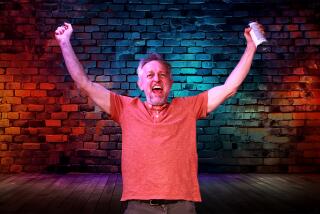STAGE REVIEWS : ‘Slaughterhouse’ Has a Grave Problem
- Share via
In Daniel O’Connor’s “Slaughterhouse on Tanner’s Close,” Edinburgh, circa 1830, is a city of usury, enmity, scientific arrogance and relentless poverty filled with social and anti-social animals on the prowl. At Pacific Theatre Ensemble, it’s a fitting environment for the true crime story O’Connor’s play explores with the surgical detachment of its villain, Dr. Robert Knox (Thomas R. Oglesby).
Knox needs fresh bodies for his anatomy and surgery classes at the Edinburgh Medical University, and, in a ghoulish twist of supply-and-demand economics, has his order filled by grave robbers.
Each party keeps the other in work. But what price knowledge? This is the brooding question bubbling underneath the play’s surface, yet it never breaks through to become O’Connor’s central concern. On that surface lie the lurid, midnight deeds of Burke (Jeffrey Josephson) and Hare (Scott Lincoln), “resurrectionists” who go from corpse-snatching to murder as a business necessity.
In a sense, this is the best possible story for a playwright to get his hooks into: a “headline” tale with deep moral implications--deeper still, in this case, since they involve a scientist in a city that saw itself as the Florence of science. As an added turn of the screw, one of Knox’s student assistants, David Paterson (Richard Lawrence Harrison), begins to question the matter. Imagine the debates, with anatomy graphics hanging on the walls in the background. Half of this play could write itself.
The play O’Connor chose to write almost discards any arguments between learned men and instead observes Burke, his girlfriend (Marcia Firesten), Hare and his wife (Jennifer Taub) as they slowly depopulate Edinburgh. A far greater time, for instance, is devoted to the pair’s discovery and perfecting of murder technique--pillow suffocation--than to any conscience wrestling.
In fact, Knox dismisses any question from Paterson or his wife. He’s so self-confident in O’Connor’s depiction, and Oglesby exudes such a cold exterior in his performance, that we’re never allowed into the vortex at the drama’s center. We get a ton of bodies without much cause and effect.
“Slaughterhouse” is given a Dickensian treatment, with more pulp than Dickens would ever let in. There are the cruel-hearted and the innocent waifs, the interstitial plots, the courtroom climax and, in O’Connor’s production in a tiny Venice storefront, a magically rich world of overcrowded, put-upon people below and a haughty elite above. Unlike what happens in Dickens, however, we never find what moves these characters, even the ones with whom we spend most of the evening.
The fun here is in the playing, and the audience gets an eyeful. Josephson, Lincoln, Firesten and Taub lead a very enthusiastic ensemble (they’re already “on” before the show, as they help you to your seat). Everyone, even Oglesby in his frigid way, finds theatrical spice to toss on the action.
Their excitement is the kind of contagious, heady virus once felt at the Company Theatre. Any actor would be excited at the chance to walk through lots of dry-ice clouds evocatively lit by Mark Hoist, try out a Scottish brogue (easy to listen to here, unlike Richard Green’s music) and put on some stunning costumes (John Brandt, Betsy Klingelhoefer and Sarah Zinsser). But where is the drama?
Performances are at 705 1/2 N. Venice Blvd., Venice, Wednesdays through Sundays, 8 p.m., until Nov. 29. Tickets: $10; (213) 306-3943.
More to Read
The biggest entertainment stories
Get our big stories about Hollywood, film, television, music, arts, culture and more right in your inbox as soon as they publish.
You may occasionally receive promotional content from the Los Angeles Times.










